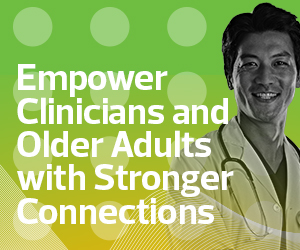Evolving Expectations for Networking in Senior Care
Having an upgraded network infrastructure to better support residents or patients allows them to maintain their independence and stay connected with their loved ones anywhere, anytime, on any device. For example, during the pandemic, when visiting was not allowed, video calls were a much-needed service for residents and patients longing to stay connected with their families.
With visits reinstated, family members coming to spend time at a resident’s home will also want better connectivity. Visitors can rest assured that remote work is possible if needed, and they can enjoy the same streaming capabilities they have in their own homes.
An updated network infrastructure can foster self-reliance among residents and give time back to staff. For instance, residents looking for information about the day’s menu or activities can find the information on a smart home device, leaving staff to focus on care.
Previously, senior living and post-acute care organizations focused on a finite amount of connectivity. Today, prospective residents or patients often ask what tech capabilities will be available to them: What’s the connectivity like? Will smart devices be provided? What about tech support? Now, along with supporting a more mobile workforce, organizations are evolving to support engaged residents or patients who are comfortable with more technology in their lives.
Updated Network Infrastructure Supports Senior Care Staff
Up-to-date infrastructure will always be more efficient for caregivers, enabling not just mobility but also point-of-service or point-of-care documentation. Being able to document care onsite, in a resident’s room, is key. Staff members who can document care in real time are able to provide more reliable and accurate documentation for billing and compliance purposes.
If organizations are willing to upgrade their network infrastructure, caregivers will see that as major support. It’s frustrating to get kicked off a work platform because there isn’t enough bandwidth to support multiple devices. An on-call employee may see the lack of investment in better infrastructure as a lack of interest in supporting better care for residents and staff.
Virtual care is also growing in the senior living and post-acute care space, especially among organizations that provide round-the-clock physician coverage through telehealth. Campuses will often have a medical director on staff, but that person is not there 24/7. Telehealth options can provide coverage after business hours and on weekends, and they can also help nursing staff connect with a physician while the patient is present so it’s not a game of phone tag for reporting vitals and decision-making.
As organizations seriously consider tech solutions that promote clinical and operational efficiency — such as telemetry monitoring and advanced fall management — updated network infrastructure will set them up for success.
The Benefits of an Updated Network Infrastructure
If they haven’t already, senior living and post-acute care organizations should consider updating prospective and current resident or patient forms with questions tied to technology use and interests. What kinds of tech are residents or patients using now? Would they be interested in a Wi-Fi bundle service?
Prospective residents or patients will have their own questions if organizations don’t offer answers first, especially if these potential community members see another organization nearby with similar amenities but better connectivity for everyone on campus.
As organizations work toward updating their network infrastructure, this is a chance for the IT team to drive conversations with their business partners — including stakeholders across departments, from clinical to marketing and more — inside and outside the enterprise.
This article is part of HealthTech’s MonITor blog series. Please join the discussion on Twitter by using #WellnessIT.















